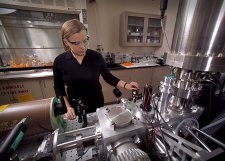Research Highlights
April 2008
Measuring Particle Shape Removes Frustrating, Simplistic Assumption
Approach allows researchers to determine particle shape

The researchers approach designed and constructed SPLAT II, a second-generation Single Particle Laser Ablation Time-of-Flight mass spectrometer, to measure particles with unprecedented sensitivity and precision. Enlarged View
Results: In the real world, particles are seldom perfectly spherical. A method for determining the irregular and often complex shapes shape of irregular particles garnered a "hot paper" listing in March 2008. Scientists from Pacific Northwest National Laboratory and Imre Consulting developed an instrument that can measure particle properties with extremely high precision from which it is possible to extract the shape of particles and how the shape impacts their behavior.
Why It Matters: When toxic atmospheric particles are inhaled, they impact public health. Atmospheric particles scatter and absorb solar radiation and determine cloud properties, playing a critical role in global climate. Particle shape is important in determining how particles move in our lungs and where they are lodged. Similarly, the climatic effect of particles also depends on their shape. By understanding particle shape, researchers can more accurately establish all other particle properties and better predict their behavior.
Methods: The researchers approach was to design and construct the instrument they call SPLAT II to conduct measurements with unprecedented sensitivity and precision. They used an aerodynamic lens that generated a particle beam of extremely low divergence and in which the velocity of each particle is precisely related to its vacuum aerodynamic diameter. By combining SPLAT II with a differential mobility analyzer, the team simultaneously measured for each particle its vacuum aerodynamic diameter, the mobility diameter, the dynamic shape factor, and the density.
For this set of experiments, the team began with clusters or agglomerates of spherical particles to test their approach and demonstrate its capabilities. These represented the first measurements of the dynamic shape factors of the agglomerates in a vacuum. The observed results demonstrated perfect agreement with theory.
By the end of the study, the team used particles commonly found in the atmosphere. They obtained the first experimental determination of the dynamic shape factor of ammonium sulfate, sodium chloride, and particles composed of organic substances, all of which are important atmospheric pollutants. Some of the results agreed with what was expected, while others were surprising. For example, they found that the dynamic shape factors of ammonium sulfate and sodium chloride increase with particle size.
In support of the SPLAT II measurements, the team used the scanning electron microscope at the Department of Energy’s Environmental Molecular Sciences Laboratory, a national scientific user facility, located at PNNL. Using this instrument allowed the researchers to obtain images that verified their conclusions.
Next Steps: The popularity of this research has led the team to extend the work and develop a new method to distinguish between particles on the basis of their asymmetry and even physically separate particles on the basis of shape.
Acknowledgments: Alla Zelenyuk and Yong Cai at PNNL and Dan Imre at Imre Consulting wrote the article. The DOE Office of Basic Energy Sciences funded the work.
Citation: Zelenyuk A, Y Cai, and D Imre. 2006. “From agglomerates of spheres to irregularly shaped particles: Determination of dynamic shape factors from measurements of mobility and vacuum aerodynamic diameters,” Aerosol Science and Technology 40(3):197-217.
